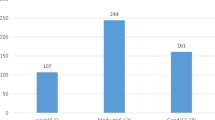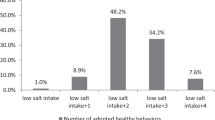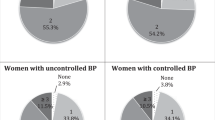Abstract
Individuals with hypertension should lower and maintain their blood pressure levels through lifestyle modification and/or pharmacotherapy. To determine whether perception of blood pressure control is related to behaviours and intentions for improving blood pressure, data from 6142 Canadians age 20+ years with self-reported hypertension were analysed. Relationships between perception of control, current behaviours for blood pressure control and intentions to improve these behaviours were examined. Although individuals who reported uncontrolled blood pressure were equally likely to report engaging in lifestyle behaviours for blood pressure control, they were more likely to indicate an intention to improve their health, compared with those who reported well-controlled/low blood pressure. These individuals were also less likely to report having enough information to control their blood pressure. In addition, they were less likely to report having been advised to take antihypertensive medication, and to be taking and adhering to medications. Individuals who perceive their blood pressure as uncontrolled have intentions to make health-enhancing changes but may lack the information to do so. The study highlights the potential need for programmes/services to help those with uncontrolled blood pressure make lifestyle changes and/or take appropriate medication.
This is a preview of subscription content, access via your institution
Access options
Subscribe to this journal
Receive 12 digital issues and online access to articles
$119.00 per year
only $9.92 per issue
Buy this article
- Purchase on Springer Link
- Instant access to full article PDF
Prices may be subject to local taxes which are calculated during checkout
Similar content being viewed by others
References
Wilkins K, Campbell NR, Joffres MR, McAlister FA, Nichol ME, Quach S et al. Blood pressure in Canadian adults. Health Rep 2010; 21 (1): 37–46.
Public Health Agency of Canada. Tracking Heart Disease and Stroke in Canada. Public Health Agency of Canada, Ottawa, 2009. Available at: http://www.phac-aspc.gc.ca/publicat/2009/cvd-avc/pdf/cvd-avs-2009-eng.pdf.
Canadian Hypertension Education Program Campbell N, Kwong MM . 2010 Canadian hypertension education program recommendations: an annual update. Can Fam Physician 2010; 56 (7): 649–653.
Statistics Canada. Survey on Living with Chronic Diseases in Canada User Guide. Statistics Canada, Ottawa, 2009. Available at: http://www.statcan.gc.ca/cgi-bin/imdb/p2SV.pl?Function=getSurvey&SDDS=5160&lang=en&db=imdb&adm=8&dis=2.
Rust KF, Rao JN . Variance estimation for complex surveys using replication techniques. Stat Methods Med Res 1996; 5 (3): 283–310.
Lawes CM, Vander Hoorn S, Rodgers A . Global burden of blood-pressure-related disease, 2001. Lancet 2008; 371 (9623): 1513–1518.
Onysko J, Maxwell C, Eliasziw M, Zhang JX, Johansen H, Campbell NR et al. Large increases in hypertension diagnosis and treatment in Canada after a healthcare professional education program. Hypertension 2006; 48 (5): 853–860.
Chobanian AV . Shattuck lecture. The hypertension paradox--more uncontrolled disease despite improved therapy. N Engl J Med 2009; 361 (9): 878–887.
Touyz RM, Campbell N, Logan A, Gledhill N, Petrella R, Padwal R et al. The 2004 Canadian recommendations for the management of hypertension: part III--lifestyle modifications to prevent and control hypertension. Can J Cardiol 2004; 20 (1): 55–59.
Prochaska JO, Butterworth S, Redding CA, Burden V, Perrin N, Leo M et al. Initial efficacy of MI, TTM tailoring and HRI's with multiple behaviors for employee health promotion. Prev Med 2008; 46 (3): 226–231.
Blackburn DG . Establishing an effective framework for physical activity counseling in primary care settings. Nutr Clin Care 2002; 5 (3): 95–102.
Clark MM, Pera V, Goldstein MG, Thebarge RW, Guise BJ . Counseling strategies for obese patients. Am J Prev Med 1996; 12 (4): 266–270.
Steptoe A, Kerry S, Rink E, Hilton S . The impact of behavioral counseling on stage of change in fat intake, physical activity, and cigarette smoking in adults at increased risk of coronary heart disease. Am J Public Health 2001; 91 (2): 265–269.
WHO. The urban environment. Available at: http://www.who.int/heli/risks/urban/urbanenv/en, Accessed 9/7/2010, 2010.
Stairway to health: welcome—public health agency of Canada. Available at: http://www.phac-aspc.gc.ca/sth-evs/english/index-eng.php. Accessed 9/7/2010, 2010.
Commuter Challenge. Available at: http://www.commuterchallenge.ca/. Accessed 9/7/2010, 2010.
Multi-Stakeholder Working Group on Sodium Reduction—Health Canada. Available at: http://www.hc-sc.gc.ca/fn-an/nutrition/sodium/sodium-working-travail-group-eng.php. Accessed 9/7/2010, 2010.
World Health Organization. Interventions on Diet and Physical Activity: What Works, Summary report World Health Organization, 2009, Geneva. Available at: http://www.who.int/dietphysicalactivity/summary-report-09.pdf.
Turnbull F, Neal B, Algert C, Chalmers J, Chapman N, Cutler J et al. Effects of different blood pressure-lowering regimens on major cardiovascular events in individuals with and without diabetes mellitus: results of prospectively designed overviews of randomized trials. Arch Intern Med 2005; 165 (12): 1410–1419.
Campbell NR, So L, Amankwah E, Quan H, Maxwell C . Characteristics of hypertensive Canadians not receiving drug therapy. Can J Cardiol 2008; 24 (6): 485–490.
Park J, Campese V . Clinical characteristics of resistant hypertension: the importance of compliance and the role of diagnostic evaluation in delineating pathogenesis. J Clin Hypertens (Greenwich) 2007; 9 (1 Suppl 1): 7–12.
Rose AJ, Berlowitz DR, Manze M, Orner MB, Kressin NR . Intensifying therapy for hypertension despite suboptimal adherence. Hypertension 2009; 54 (3): 524–529.
Schroeder K, Fahey T . Improving adherence to drugs for hypertension. BMJ 2007; 335 (7628): 1002–1003.
Author information
Authors and Affiliations
Corresponding author
Ethics declarations
Competing interests
The authors declare no conflict of interest.
Rights and permissions
About this article
Cite this article
Gee, M., Campbell, N., Bancej, C. et al. Perception of uncontrolled blood pressure and behaviours to improve blood pressure: findings from the 2009 Survey on Living with Chronic Diseases in Canada. J Hum Hypertens 26, 188–195 (2012). https://doi.org/10.1038/jhh.2011.5
Received:
Revised:
Accepted:
Published:
Issue Date:
DOI: https://doi.org/10.1038/jhh.2011.5
Keywords
This article is cited by
-
Barriers and facilitating factors for disease self-management: a qualitative analysis of perceptions of patients receiving care for type 2 diabetes and/or hypertension in San José, Costa Rica and Tuxtla Gutiérrez, Mexico
BMC Family Practice (2013)
-
Comparison of hypertension management between cancer survivors and the general public
Hypertension Research (2012)



